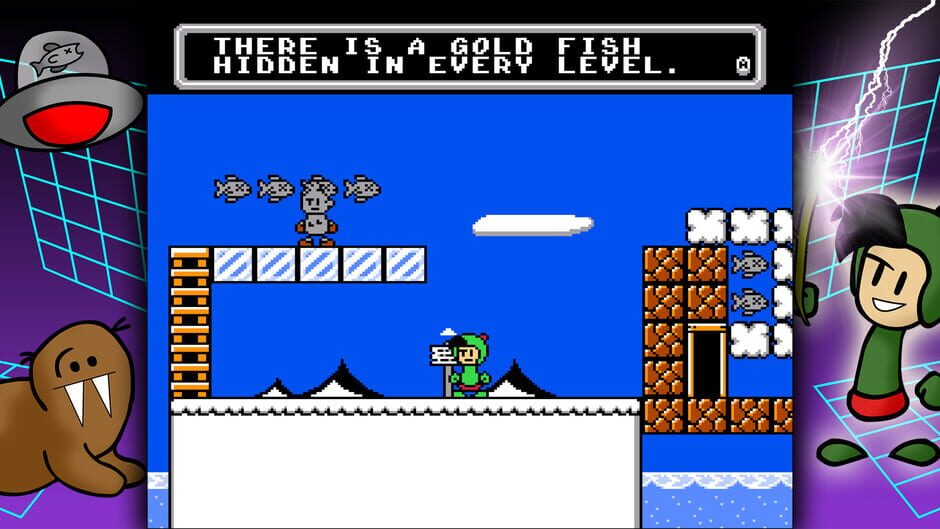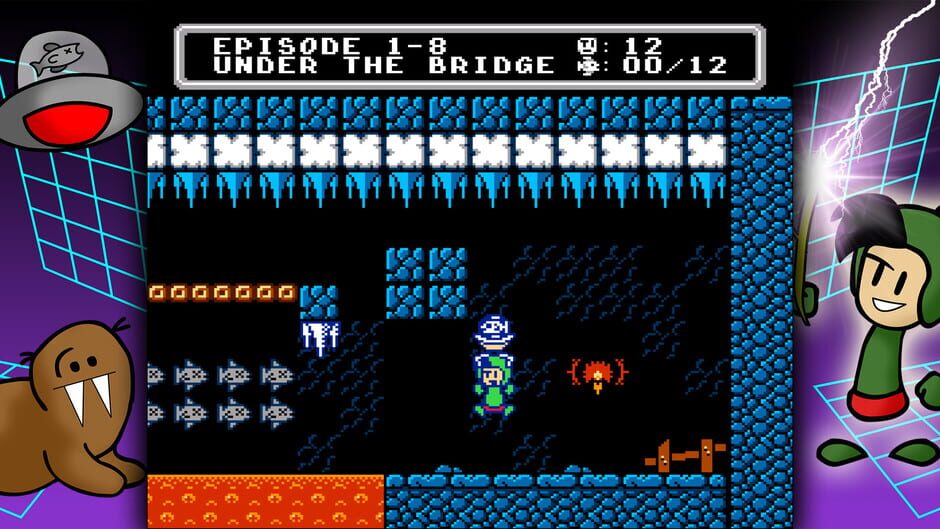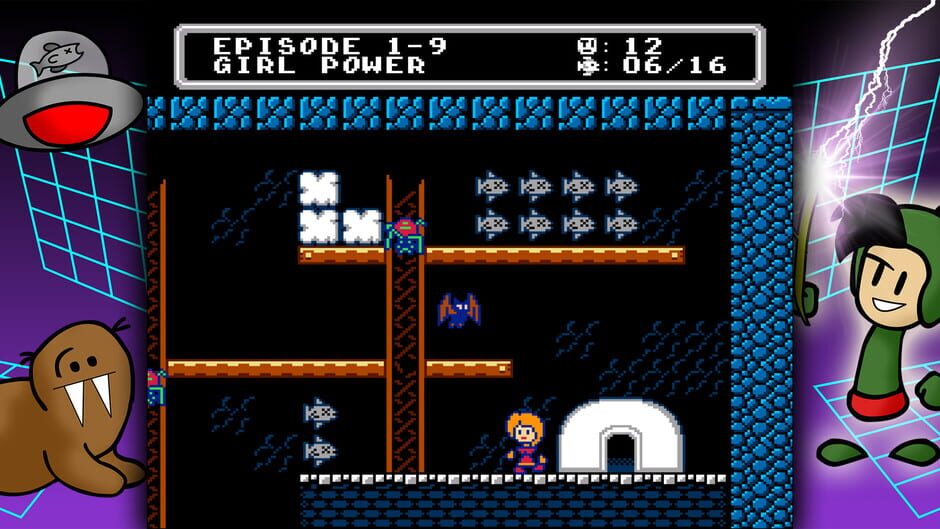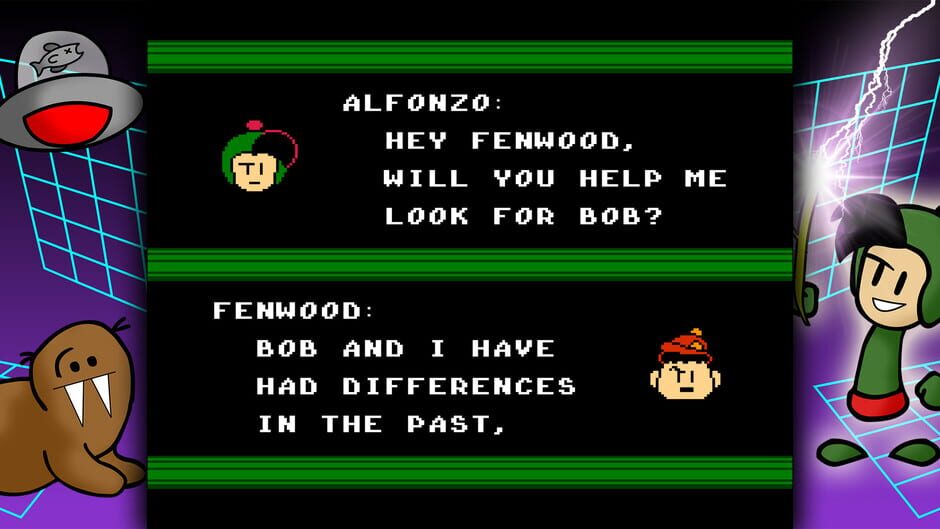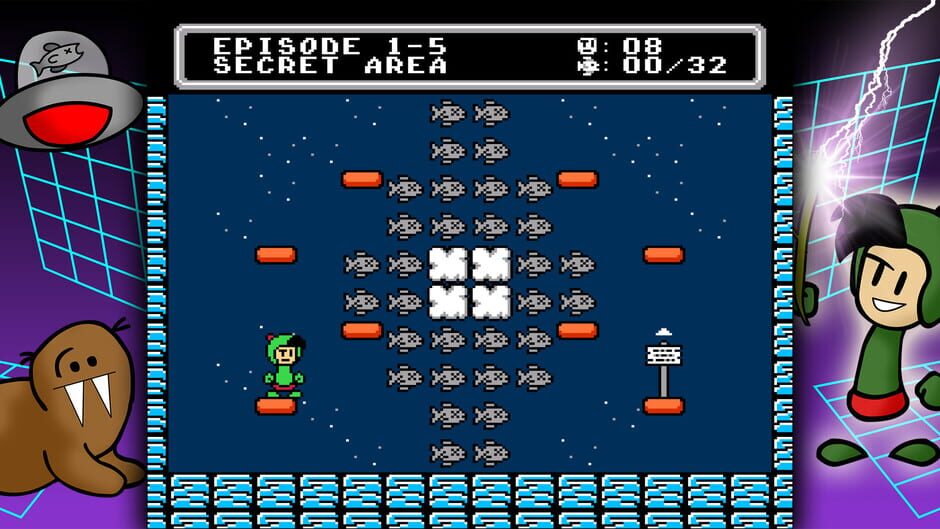Game: “Alfonzo's Arctic Adventure”
Alfonzo’s Arctic Adventure

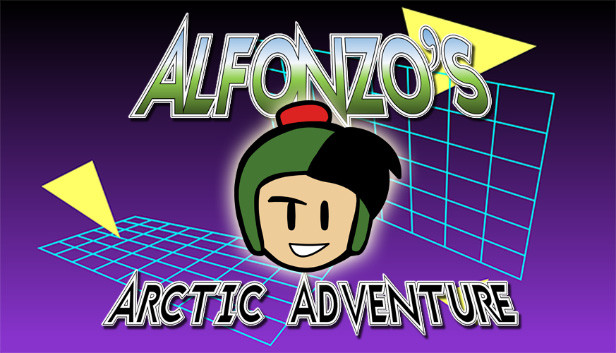
Alfonzo’s Arctic Adventure (AAA) is a modern interpretation of the classic NES-era puzzle-platformer. Indeed, the game was developed specifically for the NES by Spoony Bard Productions, and has been physically produced as a cartridge playable on the original console as part of a successful Kickstarter campaign. Now released on Xbox One/Series X/S and Nintendo Switch, by Limited Run Games, it’s quite a fun notion to have something made in the modern day, intended for use with a forty-year-old machine, and then to play it on a contemporary console. The result is a decent homage to the 8-bit video games that rescued the industry from the crash of 1983, wearing its influences with pride, and boldly embracing the limitations of the technology from that time. AAA does lean perhaps a little too far in that direction, however, and is held back by a few features and quirks that made sense in the 80s but are wholly out of place in 2021.
At A Glance
| Scores | |
| Visuals | 6 /10 |
| Sound | 6 /10 |
| Gameplay | 6 /10 |
| Overall | 6 /10 |
| Positives | + Challenging puzzle-platforming action |
| + Handles great, very responsive controls | |
| + Really nails the look and feel of the classic NES-era | |
| Negatives | – Unpredictable difficulty spikes |
| – Could do with a few quality-of-life improvements | |
| – Levels and enemies are a little bland | |
| Launch Price | £4.09 |
| Our Playtime | 10 hours |
| Available On | Nintendo Switch, PC, Xbox One, Xbox Series X/S |
Alfonzo’s is based on the Eskimo Bob video series, also made by Spoony Bard founder and lead developer Tomas Guinan, in 2001. The animated shorts are a fun time capsule to the time when the internet as we know it now was still new, and young animators were experimenting with software like Flash and Dreamweaver and sharing their creations on sites like Newgrounds. Eskimo Bob, like so many works from this time and place, starts off as a simple vehicle for slapstick humour and belch and fart jokes, but introduces something resembling an overarching plot and character development as Guinan improves in ability and gets more familiar and experienced with his storytelling and animation technique. His work earned him a loyal audience, and it’s very likely that the success of the Kickstarter campaigns for AAA and the Eskimo Bob game – to which Arctic Adventure is a sequel – owes a lot to fans of the original material.
The core gameplay of Alfonzo’s Arctic Adventure is simple enough – traverse each level and collect every fish in order to rescue the aforementioned Eskimo Bob. To do this, you’ll jump, poke and butt bash your way through obstacles and enemies in typical 2D side-scrolling fashion. You’ll make your way through six overworlds – or “episodes” – each with a unique set of stages and its own boss battle. Playing as the titular Alfonzo, you must find help from a curious cast of characters and use their unique abilities to solve puzzles and complete levels. Alfonzo, for example, is armed with his trusty stick which allows you to attack enemies horizontally and move certain objects. Magnus can jump further and has a vertical slam instead of the horizontal poke, Fenwood is impervious to most enemies but can’t attack, and a character known only as ‘The Girl’ can leap to greater heights and hurls swords through the air. For most levels, Alfonzo is the only character you’ll need, but the game adds complexity and ramps up the challenge by introducing obstacles that require you to swap out for one of his comrades. This makes for some great head-scratching moments as you try to figure out your course of action and grab that last fish. It’s interesting to note that swapping Alfonzo out isn’t always necessary and through particularly skilled platforming it’s possible to complete an area without using the other character available at the time.
The limitations on each character’s capabilities, though slight, makes playing as each of them feel very different, and deciding when is best to switch between them turns out to be a surprisingly versatile feature. There’s a bonus 2-player versus mode which is a fun addition – each player chooses a character from the cast and must battle in a very basic beat-’em-up to score the most points before time is up. This mode really highlights how different each character plays, despite having such a limited pool of abilities for them to use in the first place, and features arenas made specifically to keep these duels as fair as possible. It’s a good distraction for a few goes, though the characters aren’t quite balanced or varied enough for the mode to have a lot of staying power. Still, it’s more entertaining than expected, and a good laugh for a short while.
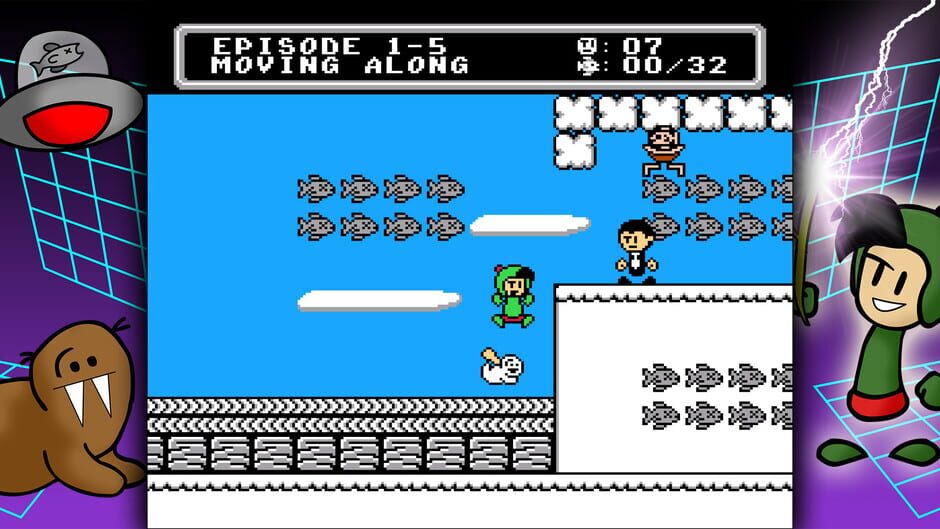
The controls, though basic, are responsive and smooth – much more so than might initially be expected, given that the titles that Alfonzo’s Arctic Adventure is emulating are often clunky, jerky or generally unwieldy. You quickly get a feel for what your character is capable of in terms of jump distance and movement speed, which allows players to breeze through the initial few levels. After this, AAA really kicks up the difficulty, which may be jarring for those who thought this would be a casual 2D romp. The platforming aspect rapidly becomes demanding and jumps require precise timing and dexterity to clear. And while most enemies can be defeated easily enough, their quick respawn rate coupled with particularly tough level design can make some sections a real slog. Those who love a challenge may enjoy the lack of hand-holding, but players who are used to a more gradual difficulty curve may slip directly off the icy surface of this game.
Unsurprisingly when considering the title, most of the levels are arctic-themed, with a small amount of scenery-swapping to change things up. With a game of this length however, it would have been nice to see a little more variation to make each episode and its component levels look and feel more distinct. Aesthetically, the game is restricted by its own geography; the arctic isn’t known for its diverse environments or inhabitants, and so the locales and enemies in AAA are limited to the rather bog standard ice, forest, and underground themes. Having said that, the boss fights that conclude each world are all surprisingly unique, with each presenting a challenge quite different to anything else in the game, and taking place in stages that stand out against the other, comparatively samey levels.
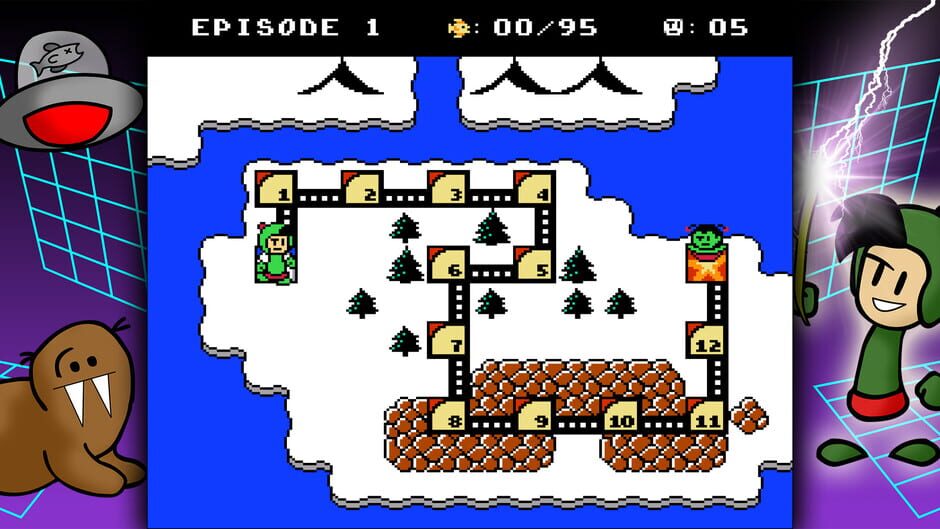
The visual style is acutely reminiscent of NES-era games such as Alex Kidd, Super Mario and Megaman – the developer’s intent to pay tribute to the titles that Alfonzo’s Arctic Adventure shares most of its DNA with is clear, and especially well realised. The overworld maps, catchy chiptune soundtrack and 8-bit graphics all contribute to an authentic retro feel. The presentation and animations of the characters and environments onscreen are wonderful in their necessary simplicity, constrained as they are by the limitations of the NES hardware. The fact that the game looks and plays so nicely on modern consoles supports the argument that hyper-realistic graphics aren’t important if fundamental game mechanics are solid and fun, as is the case here.
That said, there are a few features and stylistic choices that should have been left in the 1980’s. The whole ‘Lives/Game Over/Continue’ system is irrelevant and only wastes time – there are no consequences to running out of lives as you must restart the level upon dying anyway. Since you can only progress forwards along the overworld route and can’t backtrack to replay previous levels, selecting ‘Continue’ from the ‘Game Over’ screen puts you right where you left off anyway, making this whole sequence pointless.
Similarly bizarre and aggravating is the fact that once a level is completed, if you haven’t found any ‘undiscovered secrets’ (such as golden fish or level warps), the game presents you with the option to ‘Continue’ or ‘Retry’ the level. This would be fine, if ‘Retry’ wasn’t automatically selected, making the chance of you hitting it by mistake quite high. If you’ve just beaten a tough level that has taken you many, many attempts to complete, falling into this trap and having to battle through it all over again can be enough to make you scream.
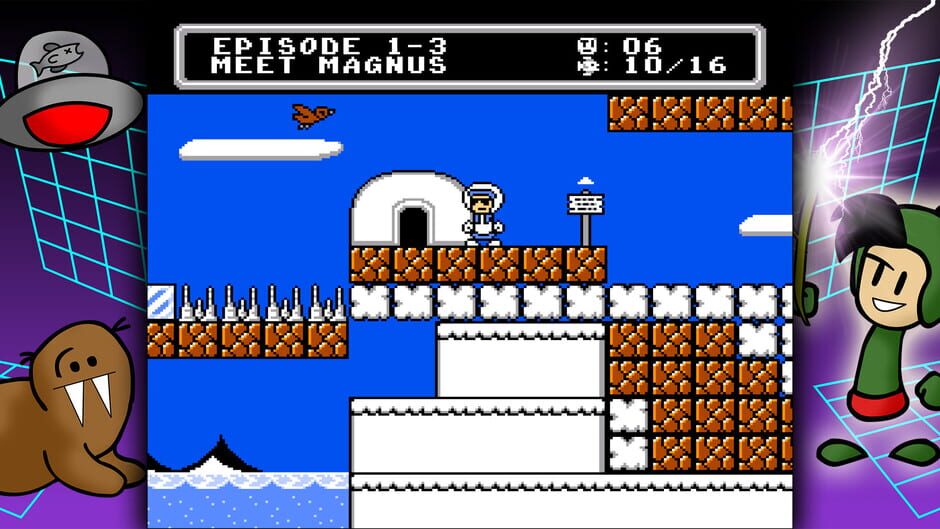
Something else that could make you scream is the game’s archaic ‘password’ system. A feature utilised by old consoles before save states or memory carts were a thing, each level has a specific code you’ll need to input to play it again. Handily, AAA is sophisticated enough to remember and autofill this info for you, allowing you to pick up right where you left off. The downside is, any tampering with this screen before you’ve completed the entire game will completely erase all of your hard earned progress unless you’ve committed these exact codes to memory – something no sane human is ever, ever going to do. While all of these quirks help solidify the game’s feel as a genuine NES product, they can also be a great source of frustration and there’s a reason why games have moved on from these systems. Unfortunately, as AAA was originally developed as a new cartridge release for the NES, the passwords are most likely necessary rather than a nostalgia-fueled inclusion.
Despite these complaints, Alfonzo’s Arctic Adventure manages to stay fresh throughout the entire experience – it finds a decent balance between challenge, frustration, and a sense of accomplishment upon completing a level. There’s not much to say about the plot – largely there isn’t one – but the brief bits of dialogue between the heroes and villains get a good chuckle every now and then. It’s likely that players familiar with the animated shorts will get much more out of this material, but crucially the game doesn’t suffer if you haven’t seen them. The gameplay takes centre stage, and it’s good and solid. Just be prepared ahead of time to resist hurling your controller through your screen as you lose yet another life to a bird shitting on you at exactly the wrong moment.
In the interest of full disclosure, the publisher provided VGamingNews with a copy of the game in order to conduct this review.


